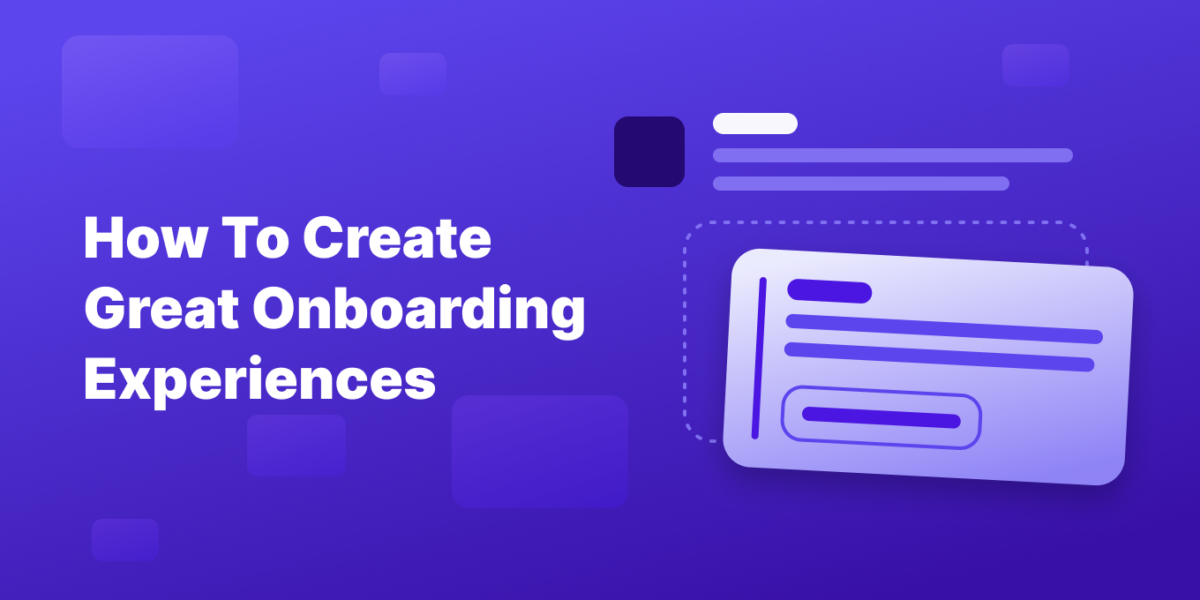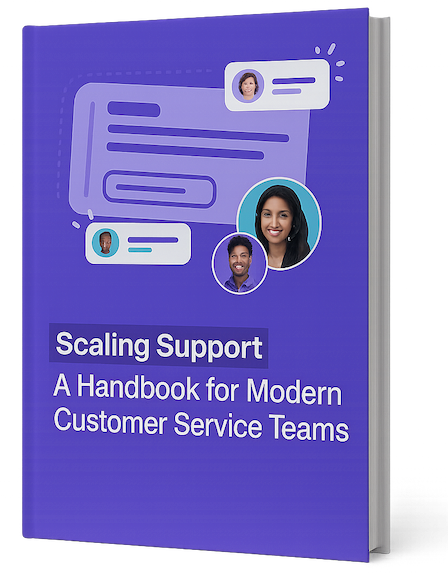You’ll never get a second chance to make a first impression.
Your customer onboarding process is that first impression. That’s why it’s essential to your customer success strategy.
Getting it right will always have a massive impact on customer success.
Here are some practical ways to show your customers that buying your product was the right choice for them.
What is customer onboarding?
Customer onboarding is how a business guides new customers or users through the initial stages of their journey with a product or service.
The key question customer onboarding tries to answer is…
How can a new customer without experience with our product maximize its potential and get the most value out of it?
It doesn’t just include the first touchpoint. It includes a few stages until a customer learns how to use the product independently.
Often, a Customer Success Manager (CSM) leads the onboarding process.
Larger CSM organizations might have dedicated teams focusing on the onboarding stage, whereas smaller companies with limited resources might focus on a tech-touch or in-app onboarding process instead.
Why customer onboarding is important
A great customer onboarding achieves two things:
- It helps your customers understand how your product works and what it does
- It brings value to customers by showing them how your tool solves the pain points they’re experiencing.
That heavily impacts your business by:
- Increasing adoption rate. Making it easy for your customers to understand the value proposition of your product means more of them are likely to use it.
- Increasing customer lifetime value (CLV). A great onboarding should educate customers about the full range of features and capabilities of your product–including the value of higher-tier plans or premium features.
- Lowering acquisition costs. It should also reduce friction, meaning that you need to acquire fewer users to achieve the same results. You could also incorporate referral programs or other initiatives to increase word-of-mouth as part of your onboarding process.
- Increasing customer retention. Onboarding aims to strengthen the relationship between your business and your customer, and addressing any issues they encounter early will reduce churn.
Investing in customer onboarding is an investment in your customers’ long-term success.
The key stages of an awesome customer onboarding flow
Understanding the stages involved in the customer onboarding process can help you craft a holistic journey and then improve your customer engagement while doing it.
The best place to start is to identify what these steps look like for your business and product. There are typically a few key features that a customer has to engage with or a few steps that a customer has to go through.
Those are the steps that form the bulk of your onboarding process. Here are a few examples of what these might look like:
- First customer touchpoint
The first touchpoint is the first interaction you have with a customer after they sign up for your product or service.
For some businesses, that might be a welcome email. Other businesses set up a kickoff call. And others might focus on the in-app experience because they don’t want you to lose momentum.
The moment you sign up for Netflix, you land on a personalized page that showcases content tailored to your individual preferences. They start by advertising the big, well-known blockbusters and immediately kick in with personalized recommendations.
That’s an extremely strong initial touchpoint.
- Product setup and onboarding steps
Some customers might already have a basic understanding of how your product works. But others will be totally new and have no idea what’s required to set up the essentials.
The setup steps are often very simple:
- They might prompt you to enter your name, select a profile picture, or fill in personal information.
- They could guide you through the very first one or features of the product.
On an app like Duolingo, that could be a language proficiency test.
For Slack, that’s creating a team, inviting members, and choosing preferences.
Creating customer onboarding templates like this one can help users quickly configure their account.
- Product walkthrough
Some products have a walkthrough.
These could happen in a few different formats.
In kickoff calls, a product walkthrough is typically part of the first meeting with a CSM. It’s a much more in-depth version of a sales demo–focused on showing a customer all the major features of a product.
Other tools focus on an in-app tutorial or might showcase video or webinar tutorials as resources for users to understand the full functionality of the product.
- Using your tool
Once clients have completed the setup process and have some understanding of how your product works, they (ideally) start using it.
This final stage is the last opportunity to help users overcome initial challenges or barriers to adoption.
It should also naturally transition users to your customer retention strategies: What keeps customers coming back and using your product?
End the onboarding experience with that.
That might mean offering ongoing support to ensure they continue to derive value from your product or service over time. It may include proactive check-ins, troubleshooting assistance, communicating feature updates, and all other customer success initiatives to drive long-term customer satisfaction and loyalty.
7 best practices for a winning customer onboarding experience
These tried-and-tested tips will help you craft a customer onboarding strategy that your customers will love.
- Personalize the onboarding experience.
- Replicate successful onboarding with a template.
- Consider a self-service help desk.
- Add Tettra as your internal knowledge base.
- Measure the impact of customer interactions.
- Provide value in your check-ins.
- Collaborate with other departments.
1. Personalize the onboarding experience
Companies can generate as much as 40% more revenue from personalization.
Customers have individual needs. And personalized outreach is always going to be more effective at addressing their pain points.
If you need to find a way to personalize at scale, there are solutions–working with templates, effective customer segmentation, or asking customers about their goals at the beginning of their onboarding.
A practical example might be:
- A customer wants to optimize their recruitment process using your product but they haven’t implemented any automations yet.
- You know that automations are one of the most valuable features of your product.
- Build in ways to contact or nudge that customer towards creating automations, either in a call, in the product, or via email.
2. Replicate successful onboarding with a template
Templates are a great tool to:
- Standardize an onboarding experience that you know works.
- Still provide personalized experience, with much less effort, through customization.
- Save time in creating that consistent experience.
A good way to start creating a template is to identify the key milestones or actions that contribute to a successful onboarding experience.
Access Tettra’s free library of templates and then modify them to make it your own.
For example, you might find that customers who complete specific tasks, such as using certain features in your software, or undergoing particular training sessions, tend to churn less. These are the tasks that you can fold into your onboarding.
3. Consider a self-serve help desk
An external knowledge base or help desk allows people to solve problems quickly and autonomously. It’s customer education in a nice package.
81% of customers attempt to take care of issues themselves before reaching out to a company, across all industries. Offering training materials like videos, tutorials, or step-by-step guides give your customers the opportunity to answer their own questions.
The trick here is to create documentation that’s tailored to your customers’ needs.
For example, sending a customer a general article like “How to create an automation” might not be very effective.
Instead, opt for functional or role-based content, like “How to use X solution for interviewers” or “How to create automations to manage candidates.”
Focusing on the outcome makes it easier for customers to see value.
4. Add in Tettra as your internal knowledge base
Beyond a self-service customer help desk, you can use Tettra as your internal knowledge base enables your customer service team to find answers to their requests more quickly and to access relevant information and help customers be more successful.
Recommended: How the Fortnox customer service team cut down their response times with the help of Tettra
- Measure the impact of customer interactions
Measure what matters.
When you invest a lot of time in customer interactions, you should have a clear understanding of the impact and value of those conversations for both sides.
Collect data and track metrics about the customers that are successful with your platform, and use that data to tailor your outreach.
It’ll make it much easier to customize your messages so they benefit customers no matter their industry, and you won’t risk sharing the same guide or tutorial twice.
- Provide value in your check-ins
Regular check-ins, quarterly business reviews, or any other meetings are an opportunity.
The goal isn’t just to “check in.” Instead, you want to provide value that will benefit your customers–every single interaction.
To prepare for a check-in, look through their account and see what’s working well or which features they haven’t used. Come to them with ideas or new opportunities. You might say something like, “I noticed you haven’t used this feature yet and it might be useful for you because…”, then share a relevant tutorial.
- Collaborate with other departments
A successful onboarding doesn’t happen in isolation.
It’s the result of an ongoing dialog between customer success and teams like sales, customer support, or product.
Your sales team will know when, where, and why customers get stuck during the sales process. You can anticipate these areas and preemptively create documentation or offer solutions.
Your product team should know exactly which features are blocking customers from being successful. Closing the loop and providing customer feedback keeps them focused on real customers and their needs.
Find answers faster with Tettra
The onboarding process is an opportunity to connect the dots between the customer’s problem and how your service can help them.
But customer onboarding is just the beginning of their journey with your product.
Translating a successful onboarding experience into long-term retention is the next major goal.
Tettra’s AI-powered knowledge management system makes it easy for CSMs to find the information they need to connect with customers. Tettra is an intuitive platform for the seamless creation, organization, and sharing of information, and it also integrates with all kinds of tools you’re probably already using.


